Andrew from BB (justintime) sent me a Mora 2000 to test in the jungle. He was keen to see how it did here.
Let me first say that I am no expert and have never reviewed a knife and dont know what the tests" are. I thought the best thing was to get the Mora to do what would normally be done by the other knives when I am in the bush and then decide if this is a knife Id be happy to have with me.
It arrived on Sunday afternoon which was just in time because on Monday morning I headed of to the hills to look for a particular type of bamboo so the Mora was able have its first taste of the jungle along the way. It had a good edge already (thanks Andrew) so nothing needed to be done
I initially thought of starting off easy, giving it a chance to get acclimatised and shake off the jet lag.
But we came across a fallen Burmese Fish Tail palm. This was too good an opportunity to miss. Felling a palm and extracting the heart would be an essential job for a knife. Normally you would use a parang as a tree type palm is a tough proposition nothing like an ornamental palm or a banana tree for instance.
So I put the Iban duku away and pulled out the Mora
The palm was in an awkward position, fallen down slope, so the first thing was to limb the trunk so I could move it to an easier location.

I used a flick cut on a frond and the Mora went almost all the way through.
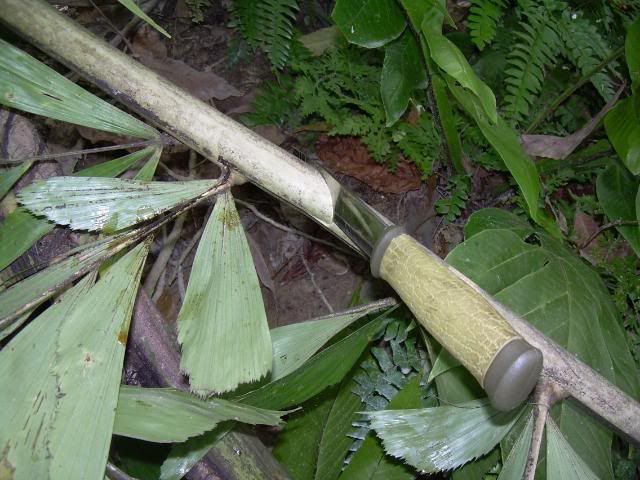
Getting used to the Mora, I tried a larger frond and this time we went all the way through
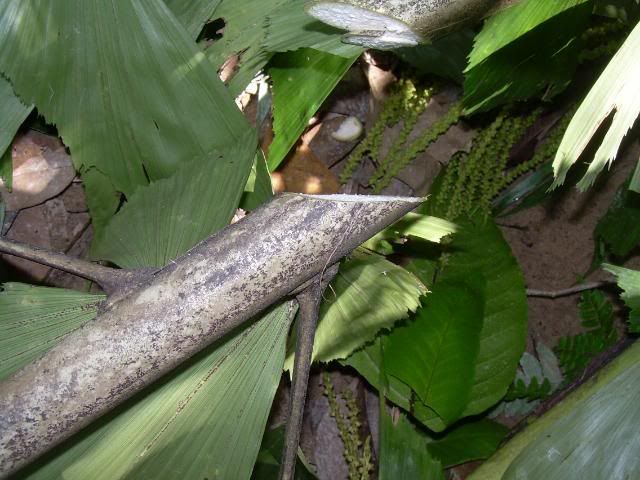
On the main trunk it was a different matter. It went in 1.5cm. By way of comparison, I later looked at the stump of a larger palm that had been felled a few months ago with a billhook and the cuts were 3.cm and 4.5cm. So this is a creditable performance. I finished the job by batoning the Mora through
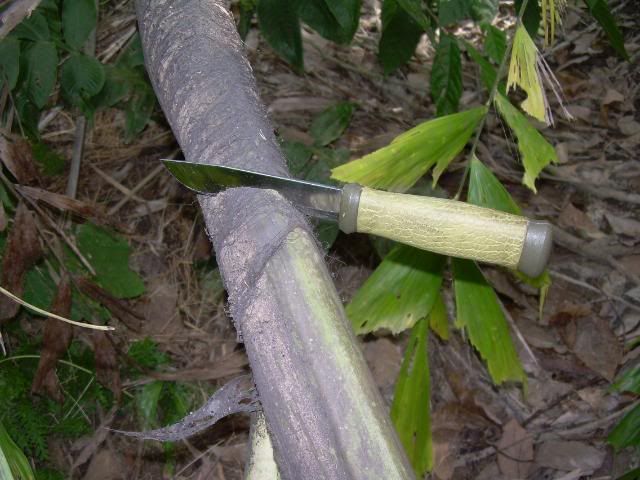
Now using a rock as a base, we got to work on the outer layers. I used a baton to get through.

This inner layer provides the fluffy scurf that was originally used in the fire pistons made by the natives of mainland South East Asia. Dried, it can be used as tinder for a fire steel as well.
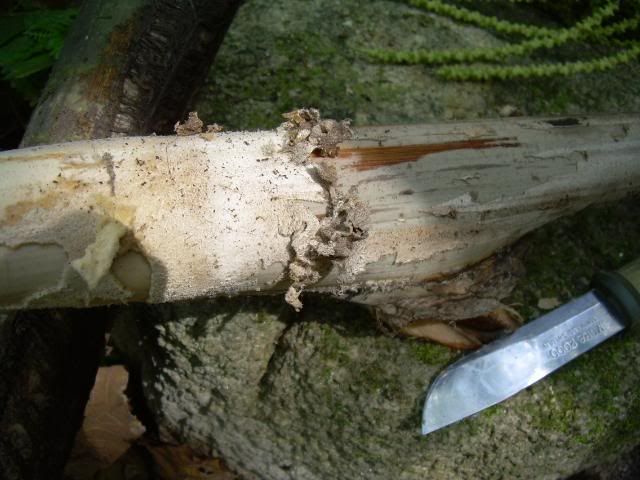
This little fellow was observing me but left after the flash went off.
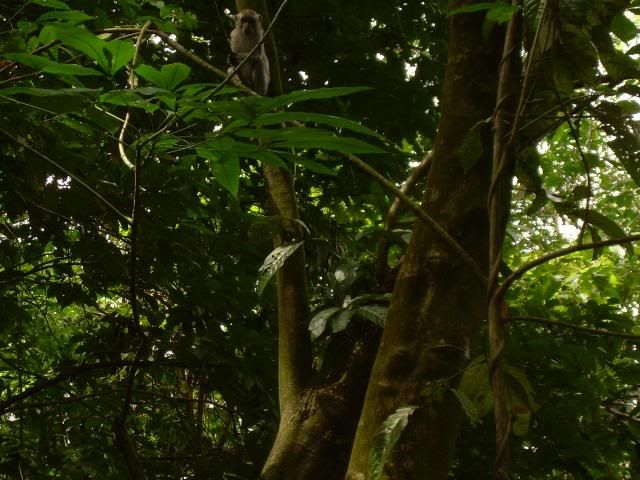
I got to a bamboo grove and started photographing and measuring it for later identification.
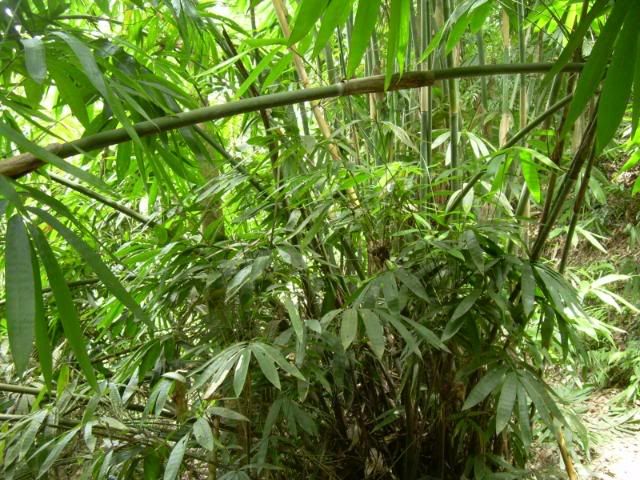
After completing that task, the Mora was put to work again.
A good knife is needed to get water if there is no stream handy and we were on the slopes of a high ridge. Two common ways of getting water are cutting a water vine or tapping bamboo. No vines around but lots of bamboo.
A few whacks on the butt and the drinking hole was made. A pointier tip would have been better, I feel, for a neater hole

And then Mora cut a bamboo straw.
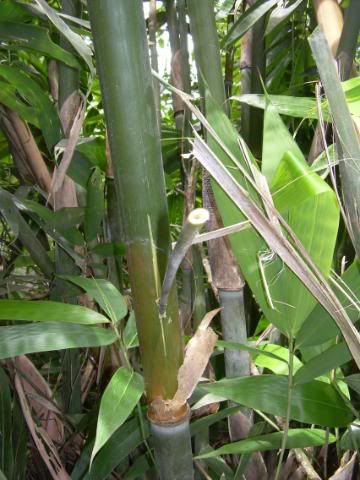
Water from bamboo is very pleasant, cool and slightly sweet tasting. Later I saw the ants get busy so I suppose there must be some dissolved sugars as well. A natural glucose drink maybe. Ive never seen ants go for water before though they are often around bamboo.

The dog was bored by all this nonsense
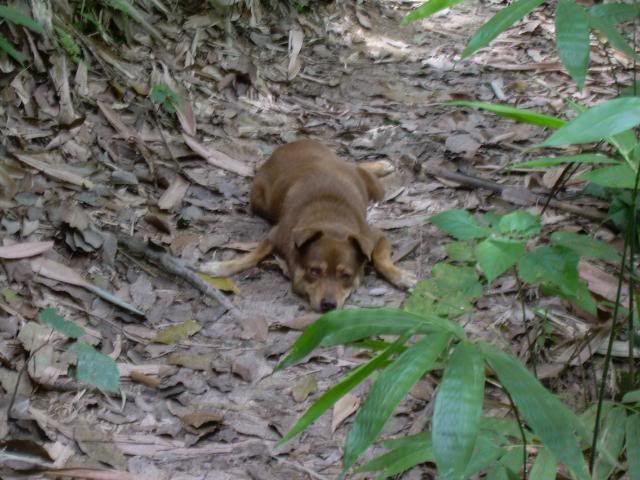
One of the most important needs in the jungle is a blade that can cut trails. And bamboo is one of the things thats often in the way.
Mora started out on some light stuff. These are the before and after photos of the trail

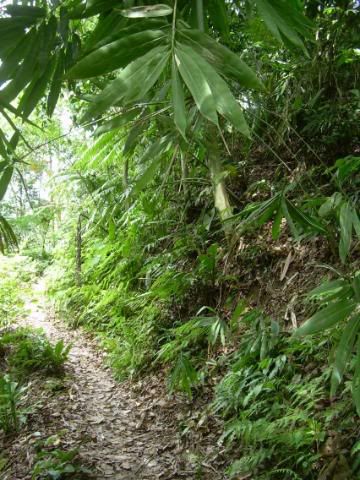
I then tried it out on larger bamboo. Bamboo is resilient and the nature of the beast is that it can be hard sometimes to cut cleanly. The Mora cut through 3cm bamboo easily in one stroke
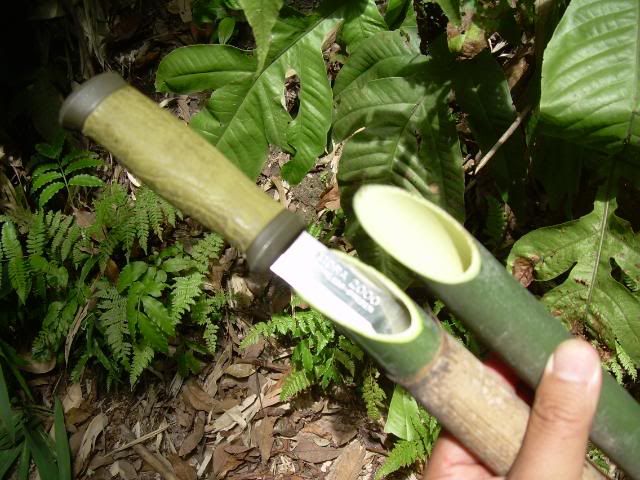
It just failed by a hair to slice through 5cm bamboo. But see that there is no fracturing of the bamboo. It came with a good edge as I mentioned. It did fracture dried bamboo though.
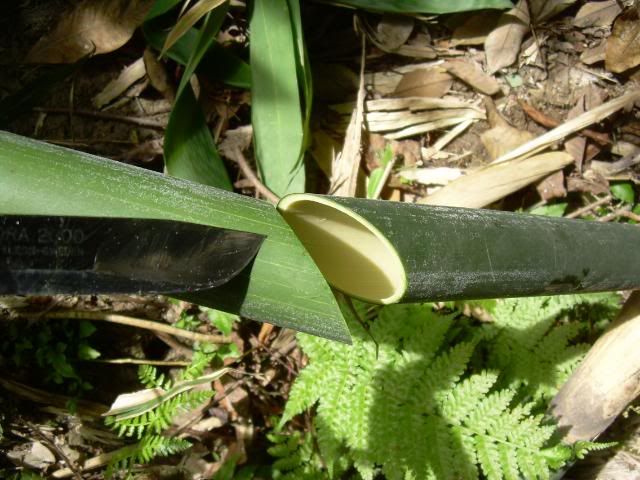
Trail work is not just bamboo though. The hard, dry hanging stuff can be hard for even a parang to get through. You can just make out a sapling behind all this mess
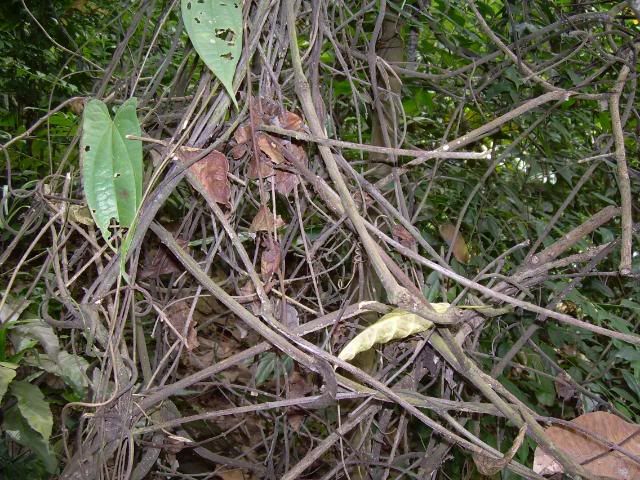
After maybe 20 seconds, the Mora cleared the way.
NOTE; I did not at anytime use my other hand to pull things away or steady the target during any of the tests.
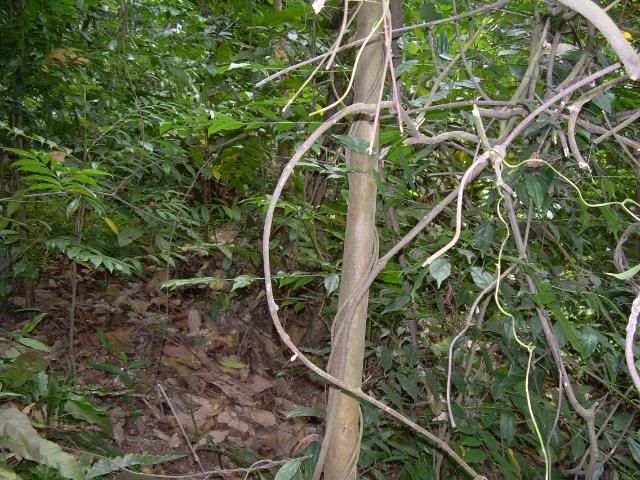
The Mora was doing well but if you were to do it regularly you would need gloves or you would end up with bleeding knuckles. By way of comparison, there no way my Al Mar could have cleared this in that time. Maybe a minute or more. I wouldnt try even. And there would be heaps of blisters.
The next test was woody green foliage. There is a tree just visible behind.
Before and After.
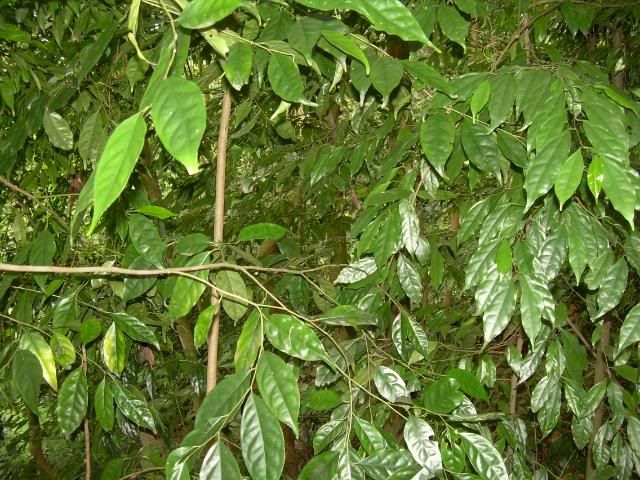
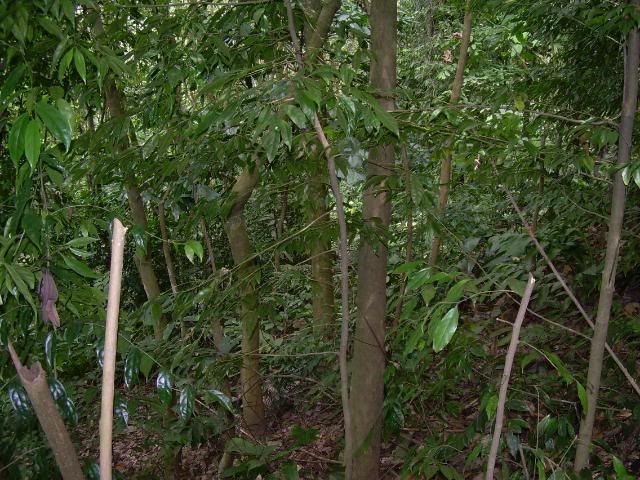
The light thin springy stuff tended to bounce off the blade so a few more strokes were needed. It would have done the same with a duku blade but the draw cut would have gone through more. Still it was not too difficult. Easier than the dry stuff.
It was time for lunch so the Mora had to clear some ferns and weeds for a fire site. It did okay but a duku would have cleared it in two or three strokes not a dozen or so. Not a fair test I agree.

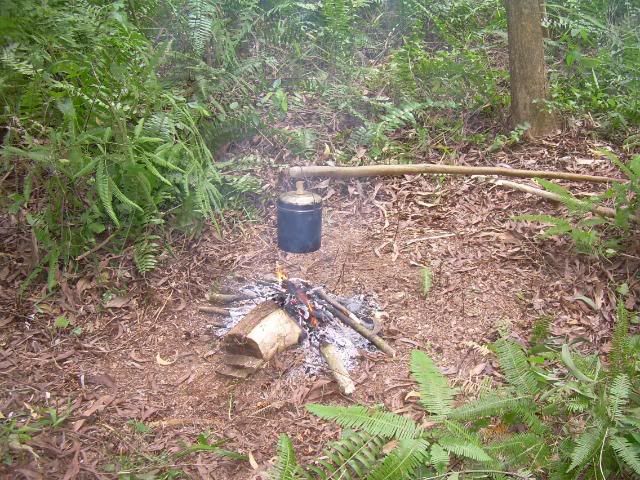
I wasnt going to insult the Mora by asking it to do what a even a SAK can do and there is seldom any need for feather sticks in the jungle but since this seems to be a usual test for a bushcraft knife, I thought maybe I should have a go. Im not very good on them and usually avoid the work. Still it was not hard to make passable sticks though in my impatience Id often slice off the ones I just cut previously
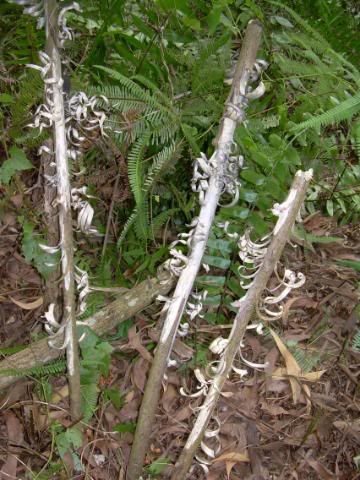
While the fire was burning I made some quick chop sticks. Unlike the feather sticks I usually make very nice chopsticks!
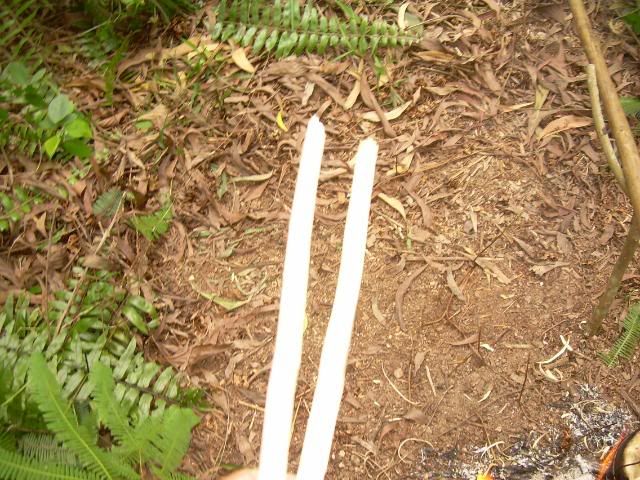
Best of all the Mora blade fitted in nicely into the handle of my Aussie army mug so I could put it into the middle of the embers for a quick brew after the instant noodle soup.
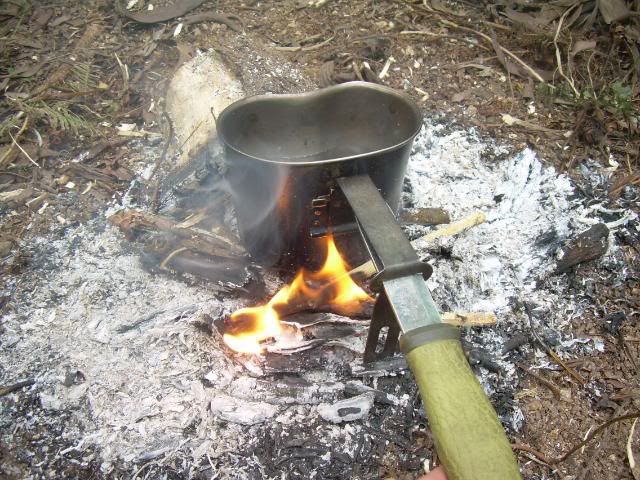
Its normal to denigrate Moras but I like the look of it and the sheath. Seems Japanese inspired somehow. I know little about steel and various grinds so wont say anything. The leather loop will be a problem in the jungle as it will rot
I think the full belly helps when using flick cuts. Also the thinner blade. Does anyone know why they have the sudden change in the shape of the flat of the blade.
Im pretty impressed with it all in all. It was not an easy outing for any small knife. Im not cleaning it so that I can see how the blade reacts to the sap nor will I sharpen it with anything brought in to the bush. I think that the bamboo can be used to sharpen the blade, after blunting in the first place
Ill take it on some longer trips and see how it copes with other ordeals and let you know.
Any suggestions for the tasks?
Let me first say that I am no expert and have never reviewed a knife and dont know what the tests" are. I thought the best thing was to get the Mora to do what would normally be done by the other knives when I am in the bush and then decide if this is a knife Id be happy to have with me.
It arrived on Sunday afternoon which was just in time because on Monday morning I headed of to the hills to look for a particular type of bamboo so the Mora was able have its first taste of the jungle along the way. It had a good edge already (thanks Andrew) so nothing needed to be done
I initially thought of starting off easy, giving it a chance to get acclimatised and shake off the jet lag.
But we came across a fallen Burmese Fish Tail palm. This was too good an opportunity to miss. Felling a palm and extracting the heart would be an essential job for a knife. Normally you would use a parang as a tree type palm is a tough proposition nothing like an ornamental palm or a banana tree for instance.
So I put the Iban duku away and pulled out the Mora
The palm was in an awkward position, fallen down slope, so the first thing was to limb the trunk so I could move it to an easier location.

I used a flick cut on a frond and the Mora went almost all the way through.

Getting used to the Mora, I tried a larger frond and this time we went all the way through

On the main trunk it was a different matter. It went in 1.5cm. By way of comparison, I later looked at the stump of a larger palm that had been felled a few months ago with a billhook and the cuts were 3.cm and 4.5cm. So this is a creditable performance. I finished the job by batoning the Mora through

Now using a rock as a base, we got to work on the outer layers. I used a baton to get through.

This inner layer provides the fluffy scurf that was originally used in the fire pistons made by the natives of mainland South East Asia. Dried, it can be used as tinder for a fire steel as well.

This little fellow was observing me but left after the flash went off.

I got to a bamboo grove and started photographing and measuring it for later identification.

After completing that task, the Mora was put to work again.
A good knife is needed to get water if there is no stream handy and we were on the slopes of a high ridge. Two common ways of getting water are cutting a water vine or tapping bamboo. No vines around but lots of bamboo.
A few whacks on the butt and the drinking hole was made. A pointier tip would have been better, I feel, for a neater hole

And then Mora cut a bamboo straw.

Water from bamboo is very pleasant, cool and slightly sweet tasting. Later I saw the ants get busy so I suppose there must be some dissolved sugars as well. A natural glucose drink maybe. Ive never seen ants go for water before though they are often around bamboo.

The dog was bored by all this nonsense

One of the most important needs in the jungle is a blade that can cut trails. And bamboo is one of the things thats often in the way.
Mora started out on some light stuff. These are the before and after photos of the trail


I then tried it out on larger bamboo. Bamboo is resilient and the nature of the beast is that it can be hard sometimes to cut cleanly. The Mora cut through 3cm bamboo easily in one stroke

It just failed by a hair to slice through 5cm bamboo. But see that there is no fracturing of the bamboo. It came with a good edge as I mentioned. It did fracture dried bamboo though.

Trail work is not just bamboo though. The hard, dry hanging stuff can be hard for even a parang to get through. You can just make out a sapling behind all this mess

After maybe 20 seconds, the Mora cleared the way.
NOTE; I did not at anytime use my other hand to pull things away or steady the target during any of the tests.

The Mora was doing well but if you were to do it regularly you would need gloves or you would end up with bleeding knuckles. By way of comparison, there no way my Al Mar could have cleared this in that time. Maybe a minute or more. I wouldnt try even. And there would be heaps of blisters.
The next test was woody green foliage. There is a tree just visible behind.
Before and After.


The light thin springy stuff tended to bounce off the blade so a few more strokes were needed. It would have done the same with a duku blade but the draw cut would have gone through more. Still it was not too difficult. Easier than the dry stuff.
It was time for lunch so the Mora had to clear some ferns and weeds for a fire site. It did okay but a duku would have cleared it in two or three strokes not a dozen or so. Not a fair test I agree.


I wasnt going to insult the Mora by asking it to do what a even a SAK can do and there is seldom any need for feather sticks in the jungle but since this seems to be a usual test for a bushcraft knife, I thought maybe I should have a go. Im not very good on them and usually avoid the work. Still it was not hard to make passable sticks though in my impatience Id often slice off the ones I just cut previously

While the fire was burning I made some quick chop sticks. Unlike the feather sticks I usually make very nice chopsticks!

Best of all the Mora blade fitted in nicely into the handle of my Aussie army mug so I could put it into the middle of the embers for a quick brew after the instant noodle soup.

Its normal to denigrate Moras but I like the look of it and the sheath. Seems Japanese inspired somehow. I know little about steel and various grinds so wont say anything. The leather loop will be a problem in the jungle as it will rot
I think the full belly helps when using flick cuts. Also the thinner blade. Does anyone know why they have the sudden change in the shape of the flat of the blade.
Im pretty impressed with it all in all. It was not an easy outing for any small knife. Im not cleaning it so that I can see how the blade reacts to the sap nor will I sharpen it with anything brought in to the bush. I think that the bamboo can be used to sharpen the blade, after blunting in the first place
Ill take it on some longer trips and see how it copes with other ordeals and let you know.
Any suggestions for the tasks?

